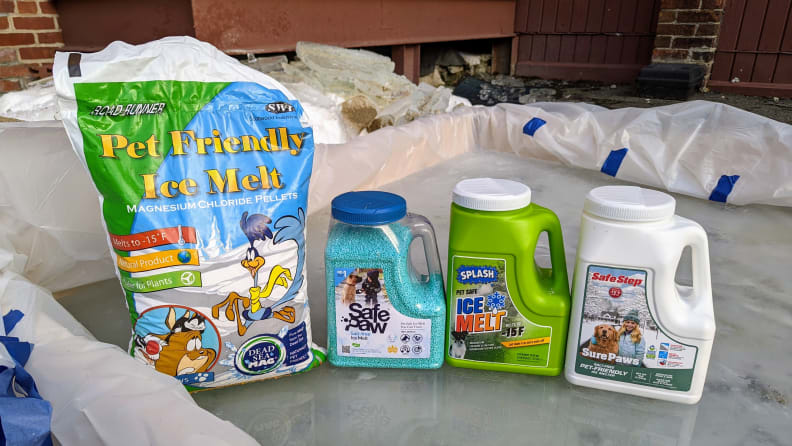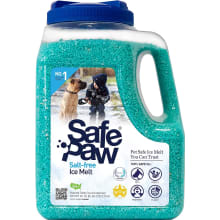Products are chosen independently by our editors. Purchases made through our links may earn us a commission.
If you get regular winter storm warnings where you live, you'll likely encounter hazardous ice. Ice melts help, but are they safe for our pets?
I live in icy New England and have two dogs who insist on being walked even if there's a freeze warning or a nor'easter on the way. This means they’ll come into contact with ice melt, and are potentially at risk. They’ll definitely get it on their paws, but I wouldn’t bet against them eating it given half a chance.
Our labrador is a walking garbage disposal who’s munched his way through a long list of items including pet and kid toys, Christmas ornaments, and flower pots, so ice melt doesn’t seem like much of a stretch for him.
Some ice melts are marketed as pet-safe or pet-friendly, but we have to ask: Do the pet-safe options actually work when it comes to melting ice?
To answer this question, we built an ice rink in Reviewed’s parking lot—basically a classic backyard rink with a wood frame and plastic liner to contain the ice—and tried a few pet- and dog-safe ice melts to see how they compare to standard ice melt. Then we checked out their ingredients so you can make a safe and informed choice.
Spoiler alert: Our favorite pet-safe ice melt is SafePaw Ice Melt

We tested four different pet-safe ice melts to see which one is best for pets.
The pet-safe ice melt that performed best on our ice rink is SafePaw Ice Melt, but all the pet-friendly ice melt products fared pretty well in comparison to a standard ice melt, Blue Heat Snow and Ice Melter.
Blue Heat doesn’t claim to be pet-friendly, and it uses a pretty standard blend of salts as the main ingredients. It contains rock salt (mostly sodium chloride), which is more harmful to pets than some other ingredients, particularly if eaten in large amounts.
We evenly sprinkled a consistent amount of each product along lanes marked on the ice, slid an ice hockey puck over them to test grip, and assessed how well the ice melt penetrated into the ice and broke up the surface. The outdoor temperature was 12°F on the day we ran our tests, so the products faced challenging test conditions.
SafePaw created about the same grip as the Blue Heat, and the colored granules made it easy to see where we’d applied the product. Blue Heat did weaken the ice surface a little more, though, and if you don’t have pets would be a better choice if you want to quickly break up ice.
Safe Paw is unusual in using a non-toxic, salt and chloride free glycol for ice melting, where most pet-friendly ice melts are salt- or urea-based. The other three popular, pet-friendly products we tried—Safe Step Sure Paws, Splash Pet Safe Ice Melt, and Road Runner Pet Friendly Ice Melt—have magnesium chloride as a major ingredient, which is considered less harmful to pets than sodium salts.
All three performed less well than the SafePaw and Blue Heat on the grip test, but they penetrated into the ice surface, and they will still work well to break up an ice layer.
When you buy ice melt you should also consider cost and how large an area you need to treat. Salt- or urea-based ice melts are inexpensive, so if you have a large area to de-ice, they are a more cost-effective choice than SafePaw.

Providing a good grip and using non-toxic glycol instead of salt or urea, Safe Paw is the best pet-friendly ice melt on the market.
Before you use it, you’ll want to know what’s in ice melt and how it works
Most ice melts contain salt, often good-old sodium chloride, i.e. the stuff you cook with.
Salts come in many forms, though, and magnesium, potassium, and calcium salts are also used. Urea is another common ingredient—that’s right, the stuff in urine, but the form used in ice melt is basically fertilizer. Glycols, like those in your car’s antifreeze, are also popular.
So, how does ice melt work? Nearly all ice melts work in the same way. The chemical ingredients attract water from the ice and dissolve, making a concentrated solution. This lowers the freezing point below that of pure water, and, if you’ve added enough chemicals, the ice should start to melt.
Some ingredients are better than others at lowering that freezing point, but it can also get so cold that ice melt will no longer work.
So, is ice melt toxic and is all ice melt safe for pets?
Ice melt ingredients like sodium, calcium, potassium, and magnesium chlorides appear as flavorings, supplements, and food treatments in our diet. Check out a pickle jar; it probably has calcium chloride listed as an ingredient (it makes your pickles crunchier).
These commonly used salts and urea aren’t poisonous in small amounts. However, they can irritate skin, and if swallowed, cause stomach upset. Propylene glycol is also a food additive and is considered safe.
You will want to avoid ethylene glycol. Although it’s a good de-icer, it’s toxic and causes environmental damage.
When it comes to pet-safe ice melts, they typically use safer chemicals than the standard alternatives, but few of them are completely harmless. Any salty ice melts can cause skin irritation, even the pet-friendly kind. They’re just less irritating than the regular varieties.
Speaking of pets who eat anything and everything, glycols have a sweet flavor, and salts are, well, salty. Both can be attractive to pets. It’s a bad idea to let your pet eat ice that contains ice melt, even if it’s a pet-friendly type. Dogs are still likely to suffer side effects like stomach upset.
Again, the ingredients chosen are less likely to cause problems than regular ice melts, but you should still be careful.
Here’s what to do when pet-friendly ice melt isn’t an option
While you can be careful about what kind of ice melt you use at and around your own home, you can’t control what your local town or city uses to keep streets and sidewalks ice-free. If you’re taking your dog for a walk off your property, they’ll encounter whatever your local town is using, and this may well be rock salt-based and not pet-friendly.
Even if they pick up more irritating ice melts, you can still keep your pet comfortable and safe. To avoid skin irritation or your dogs swallowing ice melt by licking their feet, you can clean their paws after you get home.
Cleaning wipes are an easy way to do this. We like the Earth Friendly Dog Wipes, as they’re biodegradable. Using Musher’s Secret Dog Paw Wax in the winter helps form a barrier against ice melt and soothes sore paws.
You could also try dog boots for complete foot protection. Ruffwear boots are hard wearing, and the strong Velcro strap keeps them in place.
Be aware that your dog might really hate these! I’ve got a range of reactions from being happy to wear them, to lying down, refusing to walk, and trying to eat them. In this case, cleaning and protective waxes may be the best and only option for some dogs.

Providing a good grip and using non-toxic glycol instead of salt or urea, Safe Paw is the best pet-friendly ice melt on the market.
The product experts at Reviewed have all your shopping needs covered. Follow Reviewed on Facebook, Twitter, Instagram, TikTok, or Flipboard for the latest deals, product reviews, and more.
Prices were accurate at the time this article was published but may change over time.
